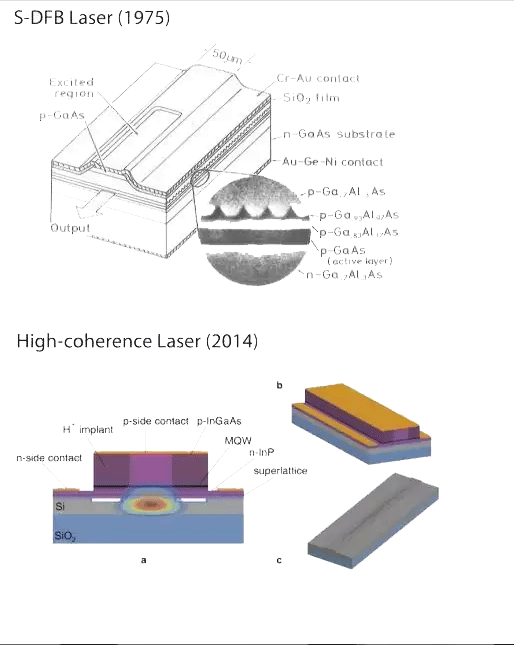New Laser For Faster Communication Developed By Caltech University
With the ever-increasing demand for faster internet, researchers from the California Institute of Technology (Caltech) have developed a new laser which increases the rate of transmission in an optical-fiber network. The work done is a five-year effort by researchers Amnon Yariv, Christos Theodoros Santis, Scott T. Steger, Yaakov Vilenchik and Arseny Vasilyev. The study was #-Link-Snipped-# in the Proceedings of the National Academy of Sciences.
Now, light has a potential of carrying huge amount of data and is one of the key features of an optical-fiber network. But even today its full potential could not be utilized. For that the laser light has to be spectrally pure – which means it has to be close to a single frequency. Hence, researchers have been striving to create a new laser that can come close as possible to emitting a single frequency. The laser used in today’s worldwide optical-fiber networks is known as distributed-feedback semiconductor (S-DFB) laser which was developed in the mid 1970. The reason why S-DFB laser’s is still being used is because, at that time, the laser had an unmatched spectral purity. With the laser’s increased spectral purity, larger bandwidth and longer transmission distance is possible in optical fibers.

The high spectral purity in the S-DFB laser was achieved by incorporating nanoscale corrugation within the multi-layered structure of the laser. This surface acted as a filter, removing all the false “noisy†waves which can contaminate the ideal wave frequency. Yariv had #-Link-Snipped-# the 2010 National Medal of Science with the main reason being that the old S-DFB laser had been successfully used for 40-years in optical communications. But the laser can now no longer satisfy ever-increasing demand for faster bandwidth.
The old S-DFB laser consist of III-V semiconductors which convert electrical current into light. But the III-V semiconductor is also a strong light absorber and can thus decrease the spectral purity. Hence, the search for a different solution began. The new laser still uses the III-V material but added a layer of silicon, which does not absorb light. The silicon layer acts as a light concentrator, which pulls the newly generated light away from the light absorbing material. The newly achieved high spectral purity is a 20 times narrower range of frequencies than possible with the old S-DFB laser. Originally, information is transferred by rapidly turning the laser on and off. But now engineers are adopting a new method called coherent phase communication, to impress the data on laser beams that no longer requires this "on-off" technique.

In coherent phase communications, data resides in the small delays in the arrival time of the waves. But the number of possible delays, is limited so as to maintain the spectral purity of the laser beam. The purity can never be perfect but with the new laser, the researchers have tried to make the purity as flawless as possible. The findings were published High-coherence semiconductor lasers based on integral high-Q resonators in hybrid Si/III-V platforms - CaltechAUTHORS.
Source: #-Link-Snipped-#
Now, light has a potential of carrying huge amount of data and is one of the key features of an optical-fiber network. But even today its full potential could not be utilized. For that the laser light has to be spectrally pure – which means it has to be close to a single frequency. Hence, researchers have been striving to create a new laser that can come close as possible to emitting a single frequency. The laser used in today’s worldwide optical-fiber networks is known as distributed-feedback semiconductor (S-DFB) laser which was developed in the mid 1970. The reason why S-DFB laser’s is still being used is because, at that time, the laser had an unmatched spectral purity. With the laser’s increased spectral purity, larger bandwidth and longer transmission distance is possible in optical fibers.

The high spectral purity in the S-DFB laser was achieved by incorporating nanoscale corrugation within the multi-layered structure of the laser. This surface acted as a filter, removing all the false “noisy†waves which can contaminate the ideal wave frequency. Yariv had #-Link-Snipped-# the 2010 National Medal of Science with the main reason being that the old S-DFB laser had been successfully used for 40-years in optical communications. But the laser can now no longer satisfy ever-increasing demand for faster bandwidth.
The old S-DFB laser consist of III-V semiconductors which convert electrical current into light. But the III-V semiconductor is also a strong light absorber and can thus decrease the spectral purity. Hence, the search for a different solution began. The new laser still uses the III-V material but added a layer of silicon, which does not absorb light. The silicon layer acts as a light concentrator, which pulls the newly generated light away from the light absorbing material. The newly achieved high spectral purity is a 20 times narrower range of frequencies than possible with the old S-DFB laser. Originally, information is transferred by rapidly turning the laser on and off. But now engineers are adopting a new method called coherent phase communication, to impress the data on laser beams that no longer requires this "on-off" technique.

In coherent phase communications, data resides in the small delays in the arrival time of the waves. But the number of possible delays, is limited so as to maintain the spectral purity of the laser beam. The purity can never be perfect but with the new laser, the researchers have tried to make the purity as flawless as possible. The findings were published High-coherence semiconductor lasers based on integral high-Q resonators in hybrid Si/III-V platforms - CaltechAUTHORS.
Source: #-Link-Snipped-#
Replies
You are reading an archived discussion.
Related Posts
Speaking with the media at the Mangalore University's 32nd convocation, Mr. K Radhakrishnan, Chairman, ISRO shared that the organisation is working on new technologies that explores possibilities of putting humans...
Vodafone Foundation in collaboration with Vodafone Spain, Huawei and Telecoms Sans Frontières has developed a portable mobile network system that fits inside a backpack. The device titled ‘Vodafone Instant Network...
Hello Friends
i am in great need of computer program for following scenario
I want to make 50 payment of 200$ with interest rate of 16.50$ and increase rate of...
Self-Driving cars have grabbed the world's attention with tech-giants like Google, Volkswagen, Audi and Nissan bringing their models. Last we saw, Researchers from Singapore-MIT Alliance had developed a driverless car...
Spice has already launched several smartphones in India at an affordable price range in the past. Continuing this trend it has launched its all new Smart Flo Poise Mi-451 at...
